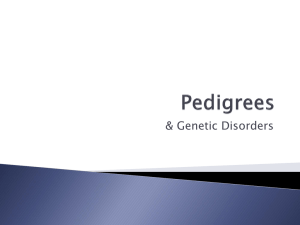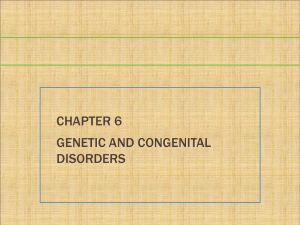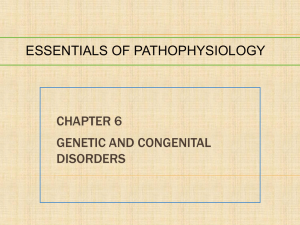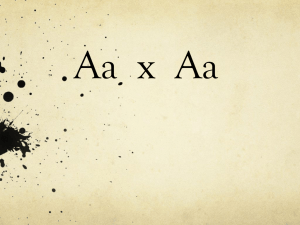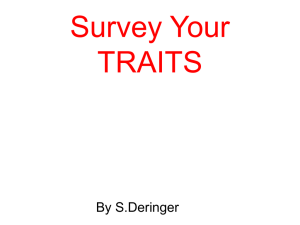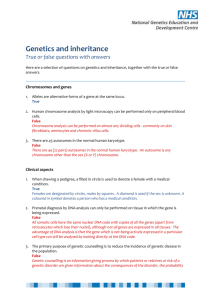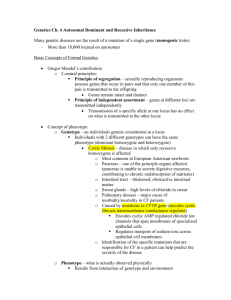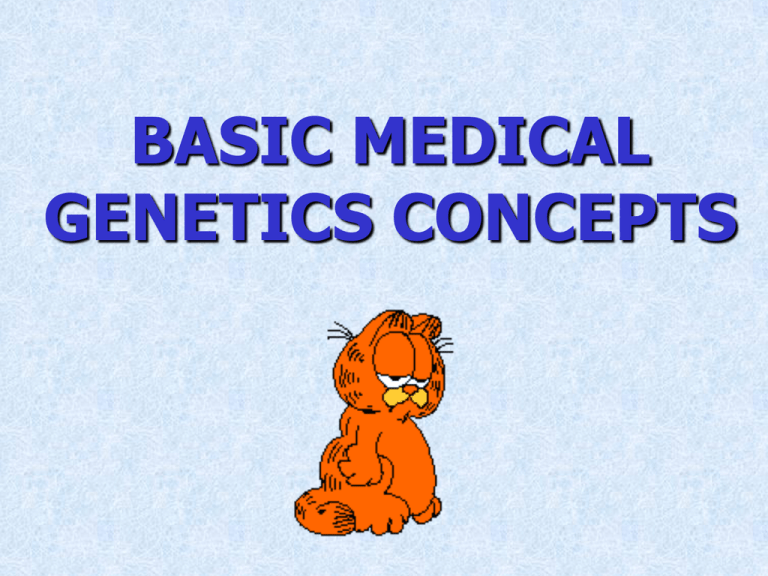
BASIC MEDICAL
GENETICS CONCEPTS
mutation effect on
protein function
phenotypic expression
classes of genetic disease
Mutations result in different alleles
• alleles are classified as “dominant” or
“recessive”
• dominant phenotypes – observable in
heterozygotes
• recessive phenotypes – observable only in
homozygotes
Mutations are classified by effect
on protein function
• loss-of-function (most common)
e.g. Decreased amount normal protein:
Inborn errors of metabolism as in Tay-Sachs [recessive]
Haploinsufficiency as in FH [dominant]
• gain-of-function
e.g. Gene dosage effects as in trisomy 21 [dominant];
Dominant-negative effect as in OI [dominant]
Abnormal protein properties as in HD [dominant]
• novel property
e.g. HbS [recessive]
• inappropriate expression
e.g. Oncogenes in cancer
Variations in phenotypic manifestation of
mutant alleles are due to:
• complementation as in XP, profound
hearing loss
• penetrance (100% - achondroplasia unusual)
• variable expression
Causes of variable expression:
• allelic heterogeneity: hemophilia variants
• locus heterogeneity: hyperphenylalanemias
• modifier loci: Waardenburg syndrome
(methylation); Alzheimer’s (multiple genes);
SNPs
• environment (XP, α-1 antitrypsin deficiency)
Common classes of genetic disease:
1. enzyme defects (PKU; Lesch-Nyhan;
Tay-Sachs; I-cell disease; XP)
• Almost always recessive.
• Pathophysiology due to substrate accumulation,
product deficiency, or both.
• When substrate is diffusible, the
pathophysiology is unpredictable; when
substrate can’t diffuse, the cell in which it
accumulates is damaged.
• Several enzyme functions can be affected.
Common classes of genetic disease (cont.):
2. Defects in receptor proteins (Familial
hypercholesterolemia)
3. Transport defects (Cystic fibrosis)
4. Disorders of structural proteins (Duchenne
muscular dystrophy; Osteogenesis imperfecta)
5. Neurodegenerative disorders (Alzheimer’s
disease; triplet repeat disorders)
6. Mitochondrial diseases (MELAS, MERRF)
7. Pharmacogenetic diseases (malignant
hyperthermia; G6DP)
Triplet Repeat Disorders
• Dynamic expansion of DNA triplet repeats
• Normal alleles polymorphic
• Inheritance dominant or recessive
• Presymptomatic, symptomatic expansion size varies
• Base sequence, location of repeat varies
• Parent-of-origin effects on repeat expansion varies
(anticipation)
• Stability during meiosis and mitosis varies (variable
expression)
Polyglutamine disorders
• Huntington Disease (autosomal dominant)
• Spinobulbar muscular atrophy (X-linked
recessive; androgen receptor)
• CAG repeat
• Anticipation: expansion occurs preferentially
during male gametogenesis
• Variable expression: mitotic instability low (limited
mosaicism)
• Protein aggregation, not loss-of-function
Fragile X Syndrome
• X-linked recessive
• CGG repeat in 5’ untranslated region of FRA gene
(posttranscriptional regulator; methylation effects)
• Most common form of hereditary mental retardation
• Anticipation: expansion occurs preferentially in
female gametogenesis
• Variable expression: Mitotic instability high
• Disease caused by loss of function; very large
expansions needed
Myotonic Dystrophy
• Autosomal dominant
• CTG repeat in 3’ untranslated region of protein
kinase gene; mechanism of pathophysiology
unknown.
• Anticipation: either parent can transmit
amplified copy; massive expansion occurs only
in maternal gametogenesis
• Variable expression: mitotic instability high
• Abnormal transcript processing, not deletions,
point mutations, etc.
Freidreich ataxia
• Autosomal recessive
• GAA repeat in intron of mitochondrial gene frataxin
(involved in iron metabolism).
• Anticipation: no parent of origin effects
• Variable expression: mitotic instability low
• Loss of function
• 4% are compound heterozygotes (expansion/point
mutation)
Mitochondrial Disorders
3 types of mutations
• missense mutations in coding regions of genes that alter
activity of OXPHOS proteins (Leigh disease-ATPase)
• point mutations in tRNA or rRNA genes that impair
mitochondrial protein synthesis (MELAS; MERRF)
• rearrangements that generate deletions/duplications in mtDNA
( not usually transmitted from affected mother to offspring;
disorders occur as sporadic new cases-Kearns-Sayre
syndrome)
Maternal inheritance
Usually heteroplasmic (phenotypic expression: reduced
penetrance, variable expression, pleiotropy)
Pharmacogenetic Diseases
• Unanticipated reactions to medications largely/entirely
genetic (6.7% incidence in American hospitals; 0.3% fatal).
• Single gene defects or multifactorial
Examples:
• Malignant hyperthermia (autosomal dominant-Ca+ release
channel; other loci)
• Acute Intermittent Porphyria (autosomal dominant
disease: drug-related alteration in gene expression of heme
biosynthetic enzyme)
• G6PD (X-linked recessive; more than 400 variants; most
common disease-producing single gene enzyme defect of
humans)
• Acetylation polymorphism (slow or rapid drug inactivation)
PRINCIPLES OF
CLINICAL
CYTOGENETICS
Common chromosome structural disorders
Chromosome banding
Aneuploidies: nondisjunction
Chromosome breakage syndromes;
translocation
Faulty DNA metabolism chromosome
syndromes
Genomic imprinting; UDP
Sex reversal
Banding
Banding
Sister chromatid
exchanges in Bloom
syndrome
Banding (FISH)
Aneuploidy: Nondisjunction
The phenotypes associated with sex chromosome
trisomies are less severe than those associated
with autosomal trisomies.
Clinical phenotype of
Turner syndrome is due to
haploinsufficiency.
Structural chromosome abnormalities
arising from chromosome breakage:
• Deletions
• Ring chromosomes
• Isochromosomes
• Translocation
Deletions
Cri du chat, 5p-
Ring Chromosomes;
Isochromosomes
Translocation
examples and consequences
Translocation
Robertsonian
translocation
Reciprocal translocation
46,XY,t(11;16)(q24;q23)
Translocation
PAIRING AT MEIOSIS
Translocation:
non-random X-inactivation
Structural chromosomal abnormalities
arising from faulty DNA metabolism:
• Slipped mispairing during DNA replication
• Nonreciprocal recombination
Slipped mispairing during
DNA replication
MN/P
N = normal
P = unmethylated premutation
MN/P = methylated normal or
premutation
F = methylated full mutation
EclXI: methylation sensitive
Non-reciprocal recombination
Non-reciprocal recombination
Genomic Imprinting:
• mechanism
• distribution
• consequences
Map of Imprinted
Regions in Human
Genome
Maternally inherited
homolog (left)
Paternally inherited
homolog (right)
gene A
Genomic Imprinting
Sex Reversal:
Role of the sry gene
Sex reversal due to translocation of SRY from Y to X

